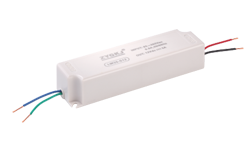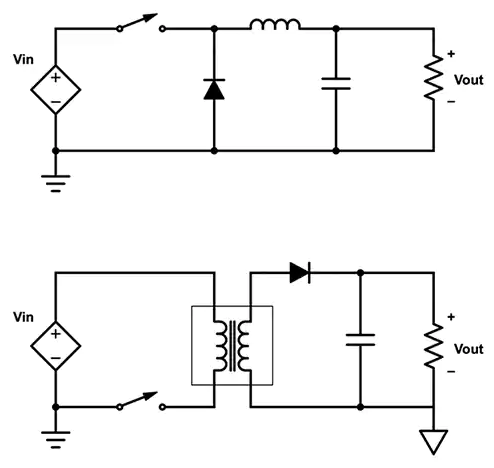albisteak
Bidirectional DC DC Converter: Principles, Topologies, and Applications
Egilea: ZYG Power Module Time: 2023-6-24
A bidirectional DC-DC converter is a power electronic device that can transfer electrical energy bidirectionally between two DC voltage levels. It is widely used in various applications, including electric vehicles, renewable energy systems, and battery energy storage systems. This article will explore the principles, topologies, and applications of bidirectional DC-DC converters.
Principles of Bidirectional DC-DC Converter
The main function of a bidirectional DC-DC converter is to transfer power from one DC voltage level to another. The power transfer can be either unidirectional or bidirectional. A bidirectional converter can transfer energy from a high voltage source to a low voltage load and vice versa. Bidirectional DC-DC converters typically consist of two power converters, each with its own power switch and control circuit. One converter operates in the forward direction, transferring energy from the input voltage to the output voltage, while the other converter operates in the reverse direction, transferring energy from the output voltage to the input voltage.
The operation of a bidirectional converter is controlled by a feedback loop that adjusts the duty cycle of the power switches to maintain the desired output voltage level. The duty cycle determines the amount of time the power switch is on during each switching cycle. By adjusting the duty cycle, the output voltage can be regulated to a desired level.
Topologies of Bidirectional DC-DC Converter
There are several topologies of bidirectional DC-DC converters, including full-bridge, half-bridge, and interleaved. Each topology has its advantages and disadvantages, and the choice of topology depends on the specific application requirements.
The full-bridge bidirectional DC-DC converter is a popular topology used in high-power applications. It consists of four power switches arranged in a bridge configuration. In the forward direction, the input voltage is applied across the diagonal of the bridge, while the load is connected across the other diagonal. In the reverse direction, the input and output terminals are swapped, and the converter operates in the opposite direction.
The half-bridge bidirectional DC-DC converter is a simpler topology that uses two power switches. In the forward direction, the input voltage is applied across one switch, while the load is connected across the other switch. In the reverse direction, the input and output terminals are swapped, and the converter operates in the opposite direction.
The interleaved bidirectional DC-DC converter is a more complex topology that uses multiple power converters in parallel. This topology has the advantage of reducing the input and output current ripple and improving the overall efficiency.

Applications of Bidirectional DC-DC Converter
Bidirectional DC-DC converters are widely used in various applications, including electric vehicles, renewable energy systems, and battery energy storage systems. In electric vehicles, bidirectional converters are used to transfer energy between the battery pack and the vehicle\’s electrical system. The converter can charge the battery pack when the vehicle is braking or decelerating, and it can discharge the battery pack to power the vehicle\’s electrical system when accelerating.
In renewable energy systems, bidirectional converters are used to transfer energy between the DC voltage level of the renewable energy source, such as a solar panel or wind turbine, and the DC voltage level of the load or the battery storage system. The converter can also transfer energy from the battery storage system to the load when the renewable energy source is not available.
In battery energy storage systems, bidirectional converters are used to charge and discharge the battery pack. The converter can charge the battery pack when excess energy is available from the grid or a renewable energy source, and it can discharge the battery pack to supply power to the load when needed.
Conclusion
In summary, bidirectional DC-DC converters are important power electronic devices that can transfer energy bidirectionally between two DC voltage levels. They are widely used in various applications, including electric vehicles, renewable energy systems, and battery energy storage systems. The choice of topology depends on the specific application requirements, and the operation of the converter is controlled by a feedback loop that adjusts the duty cycle of the power switches to maintain the desired output voltage level.
Aurrekoa: ZP Series AC DC Converter – Efficient Power Conversion Solutions
Hurrengoa: Medical Power Series: Empowering Healthcare Professionals and Patients for Better Health
informazio garrantzitsua
-
2023-9-25
DC-DC Power Supply Module price: Efficient and Reliable Solution for Power Conversion
Introduction: In today's technologically advanced world, power conversion plays a crucial role in various industries. From consumer electronics to automotive applications, efficient and reliable power conversion is essential for the proper functioning of devices. One of the most popular solutions for power conversion is the DC-DC power supply module. This module offers numerous advantages over traditional power conversion methods, making it an ideal choice for many applications. Efficiency and Reliability: The primary advantage of using a DC-DC power supply module is its high efficiency. This module efficiently converts the input voltage to the desired output voltage, minimizing the power loss during the conversion process. Traditional power conversion methods, such as linear regulators, often result in significant power dissipation, leading to...
Ikusi xehetasunak -
2023-10-20
Introduction to DC-DC Power Supply Modules: Advancements in Power Distribution Technology
Power supply modules play a crucial role in various electronic devices and systems by converting one form of electrical energy into another. Among the different types of power supply modules, the DC-DC power supply module is a notable advancement in power distribution technology. This article aims to provide an overview of DC-DC power supply modules, discussing their working principles, advantages, applications, and recent advancements. Working Principles of DC-DC Power Supply Modules DC-DC power supply modules are designed to convert a direct current (DC) voltage from one level to another. This conversion is achieved by using switching techniques, such as pulse width modulation (PWM) or pulse frequency modulation (PFM), along with various topologies, including buck, boost, buck-boost, and isolated modules. These...
Ikusi xehetasunak -
2023-4-25
Building a 120V AC Power Supply for 3V DC Output
Introduction In this project, we will be designing a 120V AC power supply that will convert the high voltage AC input to a low voltage DC output of 3V. The power supply will be used to power small electronic devices that require a low voltage DC supply. Design The first step in designing the power supply is to select the components required for the circuit. We will be using a step-down transformer to reduce the high voltage AC input to a low voltage AC output. The AC output will then be rectified using diodes, and the resulting DC voltage will be filtered using capacitors to remove any residual AC ripple. Finally, the regulated DC voltage will be produced using a...
Ikusi xehetasunak -
2023-5-26
AC DC Converter Module: Streamlining Power Conversion for Enhanced Efficiency
The AC DC converter module is an essential component in modern electrical systems. It efficiently converts alternating current (AC) to direct current (DC) to power electronic devices. This process is vital because many portable devices rely on batteries that require DC power. The converter helps to streamline the power conversion process, ensuring that devices receive reliable, regulated, and stable power. The converter module consists of several components, including a transformer, rectifier, and filter. The transformer steps down the voltage from the AC power source, while the rectifier converts the AC to DC power. The filter then smoothens the output, removing any unwanted noise or ripple. In addition, the converter module can be designed to provide various output voltage levels, making...
Ikusi xehetasunak -
2023-10-16
Unleash the Power: Discover the Best Fully Modular Power Supply
In the world of technology, power is everything. Whether you are a gamer, a content creator, or simply a tech enthusiast, having a reliable and efficient power supply is crucial for your system's performance and overall experience. One power supply that stands out from the rest is the fully modular power supply. With its advanced features and flexibility, it is truly a game-changer. A fully modular power supply is designed to provide maximum customization and convenience. Unlike traditional power supplies, where all the cables are permanently attached, the fully modular power supply allows you to connect only the cables you need. This means you can eliminate unnecessary clutter and optimize airflow within your system, resulting in better cooling and improved...
Ikusi xehetasunak -
2023-5-2
Industrial AC-DC Converter for Efficient Power Conversion
Industrial AC-DC converters are devices that convert alternating current (AC) to direct current (DC) for use in industrial applications. They are designed to provide efficient power conversion, enabling industrial equipment to operate reliably and efficiently. These converters are typically used in industrial processes such as manufacturing, automation and control systems, and power distribution systems. The primary function of an AC-DC converter is to convert the voltage and frequency of incoming AC power to the appropriate DC voltage required by the equipment. This requires a complex circuitry that includes a rectifier, filter, and voltage regulator. The rectifier converts the AC voltage to DC while the filter smoothes out the output voltage, and the voltage regulator ensures the output voltage is maintained...
Ikusi xehetasunak

















